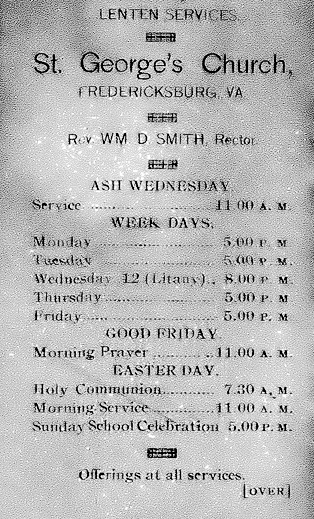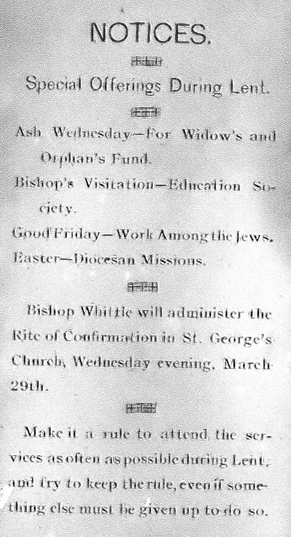
The next to the last year of the 19th century saw Easter fall on April 2nd. William D. Smith was the rector at St. George’s having assumed that position as of January, 1897 at the tender age of 34. St. George’s was a traditional place. Marshall Hall had been superintendent of Sunday school for 34 years in 1899. Change tended to move at a slow pace. For instance, the Vestry had voted in favor of retaining gas over electricity a decade earlier and in 1890 had purchased eight new gas lights.
Unfortunately, finances were tight in 1899. Smith called the Vestry to a meeting two months before Easter anxious to have the Lenten offerings appropriated to outreach – mission programs. He was opposed by the Chairman of Finances who stressed that the money should be retained internally since “finances of the Church were in such a low state.” The Vestry decided to support the Chairman.
When the Vestry had called Smith in late 1896, Judge Wellington Wallace said the Church could not pay Smith the former rector’s salary of $1,500 “without bringing the Church into debt.” They wanted to pay below $1,300 but realized they couldn’t offer him less than what he had been paid in his former Parish. They compromised on $1,400.
 The inside of the Church had suffered in appearance in the late 19th century. In 1894 the Vestry minutes noted “a good deal of the frescoing was pealing off’ of the walls.” Even repair costs seemed difficult to come by. Storm damage in 1896 caused $300 in needed repairs. In the end two members of the Vestry lent the Church funds to cover the repairs. Eventually envelopes were sent to parishioners to contribute directly toward the repayment of the debt.
The inside of the Church had suffered in appearance in the late 19th century. In 1894 the Vestry minutes noted “a good deal of the frescoing was pealing off’ of the walls.” Even repair costs seemed difficult to come by. Storm damage in 1896 caused $300 in needed repairs. In the end two members of the Vestry lent the Church funds to cover the repairs. Eventually envelopes were sent to parishioners to contribute directly toward the repayment of the debt.
Still, ways were found to enhance the Church. The women of the Church brought in a new pulpit replacing the existing lectern. It was likely at this time the back row of pews was removed to provide a walkway between aisles. While excitement was brewing for Easter, the 50th anniversary of the 1849 building would be celebrated on April 24th and reported the next day by the Free Lance-Star.
If financial problems were not enough, personnel issue plagued Smith. The organist/choir director submitted her resignation since some of the paid choir members were not only not going to practice but not showing up to sing on Sunday. The Vestry pledged to handle the issue and not accept the resignation though the director later drowned in the Rappahannock. We can only speculate whether it was an accident.
Earl Baughman recently recovered a memento from that period. It is a card of Lenten services from 1899 that was dropped in back of one of the columns in the gallery and forgotten for almost 110 years. Printing a special card for such an event is interesting in itself. Why were the cards printed? One can speculate that besides the newspaper and word of mouth, there were few ways to get the word out. Where would they be placed? Not on refrigerators since they were not introduced until World War I.
Based on the card, services were held each day during Lent at 5:00PM except for Wednesday at 8PM with an additional service at 11AM on Ash Wednesday and Good Friday. The card mentioned the “Litany” on Wednesday . Prior to the 1979 edition, prayer books had only one service labeled the Litany, and that would be the service that we now call the Great Litany. Thomas Cranmer’s original plan in 1549 was for it to be read every Wednesday, Friday, and Sunday. The 5:00PM hour service would not have been unusual in an agricultural economy in the winter/spring with less work to do. The focus on Easter day was one service held at 11AM and the Sunday school celebration at 5:00PM. Apparently, there was no Easter vigil – it would be revived much later in our time.
The financial needs of the Church may have led to the statement of “offerings at all service.” Without saying as much, these funds would have been retained by the Church. However, there appears to have been some compromise with the Rector. For four of the services including Easter, funds would be donated to special causes. Presumably the largest service at Easter would go to Diocesan missions which pleased Rev. Smith
The donations often targeted specific groups of people on specific days — orphans and widows and Jews and then specific causes, education and Diocesan mission. From a reading of the Vestry minutes donations to Jewish groups appeared frequently. In 1895, among the list of missions was $15 toward Jewish groups. This could have gone to the Anglican Diocese of Jerusalem, which was founded in 1841 as a joint effort with the Lutherans, but it became a solely Anglican mission in 1887. Another possibility would be support of the CMJ, the English society that used to be called the Church Ministry to the Jews.
In 1899 and in our own time Easter week is always an intense week with many services. In 1899 confirmation was held at the same time with a visit from the Bishop. The Vestry also traditionally met on Easter Monday and organized for the year. After reading the list of services, some may have been tempted not to attend all services. The Victorian age is evident in the last statement – “Make it a rule to attend the services as often as possible during Lent and try to keep the rule, even if something else must be given up to do so.” The possibility of diversions from Church even before the age of the radio, TV and the internet certainly connect us back to this period.
